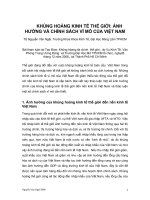Macro midterm
Bạn đang xem bản rút gọn của tài liệu. Xem và tải ngay bản đầy đủ của tài liệu tại đây (249.32 KB, 2 trang )
Macroeconomic for public policy
Midterm examination
11 Feb, 2017
Note:
1. This exam is one hundred-point scale.
2. You won’t get any credit for answers without explanation.
Problem 1:(15 points)
Which of the following options are correct? For choice of incorrect one, explain in detail why it is wrong.
1. As a general rule, GDP covers all transactions in the market. However, since trading of used
items is not an increase in total amount of newly produced goods and services, this transaction
is not included in GDP.
T
2. Holders gain profits as prices of antiques rise. This is value-added.
F
3. After a firm enlarges its scale of production, its stock price increases. Because this increase is
associated with the increase in production, it has to be included in GDP.
F
̅ does not affect the real sector,
4. In the long-run equilibrium, increasing the money supply 𝑀
right
(wrong)but it can reduce the nominal interest rate. F
5. Think of a world with no change in its labor force. The natural unemployment rate is positive,
thus in long-run equilibrium, the number of inflows to unemployment is always greater than
that of outflows from unemployment. F
pool of unemployment
positive --> fixed
a%
Problem 2:(10 points)
1. Explain in detail the principle of equivalence of three approaches.
b%
a=b
2. Write down the Fisher equation. Please explain the economic intuition of this equation.
Problem 3: (10 points)
Suppose that the base year is 2000, and the market basket contains two items, apples and pencils.
The quantity and price of apples and pencils in year 2000 and 2012 are as follows. Calculate the
inflation rate for the Laspeyres (CPI) index.
Year
2000
2012
Price (yen)
Quantity
Price (yen)
Quantity
Apple
200
1,000
100
2,000
Pencil
100
2,000
200
1,000
1
= 1.25
Problem 4. (10 points)
Suppose the average nominal wage level (hourly wage) in 2020 is 2,000 yen. Assuming that real wages
have increased by 20% during that time: the price level in 2030 is 105 whereas 2020 is taken as 100.
What is the average nominal wage level (hourly wage) in 2030?
Problem 5. (10 points)
A firm has three investment projects, A, B, and C. Each project requires investment amount of 100
units of goods. Project A will bring a profit of 20 units of goods next year, thus the rate of return is
20%. Project B's rate of return is 10%, and C's is 5%. Draw investment demand curve on a plane.
Label vertical axis “interest rate (𝑟)” and horizontal axis “investment demand (𝐼 𝐷 )”.
Problem 6. (30 points)
Gross production function of a country is Y = A𝐾 ∝ 𝐿1−𝛼 . According to the statistic office, technology
level, capital share, capital stock, and labor force of this country this year are as follows.
̅ = 8, 𝐿̅ = 27
A = 5, α = 1⁄3 , 𝐾
Consumption function and investment function have the form of
𝐶 𝐷 = 0.75(𝑌 − 𝑇) + 10 ;
𝐼 𝐷 = 10 − 100𝑟
Furthermore, government purchase, tax, and net export are given as G = 𝐺̅ = 15, T = 𝑇̅ = 10, 𝑁𝑋 =
̅̅̅̅
𝑁𝑋 = 0.
𝑀 𝐷
Money demand function is ( 𝑃 ) = 45 + 2.5𝑌 − 200𝑖
̅ = 500,and 𝜋 𝑒 = 0.05
where 𝑀
(1)
What are the ①marginal propensity to consume、②subsistence levels of consumption?
(2)
Find the following terms in long-run equilibrium ①gross product,②real interest rate, ③
nominal interest rate,④price level
If the government purchase 𝐺̅ increases by 1 unit, what is the new values of 4 terms in question
(3)
(2).
(4)
decrease
If tax 𝑇̅ increases by 1 unit, what is the new values of 4 terms in question (2).
(5) Are results in question (3) and (4) different? If there is any difference, explain intuitively.
※ Regarding question (3) and (4), similar part in solution process of question (2) can be omitted.
Problem 7: (15 points)
Consider Solow-Swan model in a country. Assume that there is no change in population across
time. Production function is Y = 𝐾
1⁄
3
∙ (𝐴 ∙ 𝐿)
2⁄
3.
Saving rate, technology level, labor force, and
depreciation rate are as follows: s = 0.2, 𝐴 = 𝐴0 = 8, L = 1, d = 0.2. At time 0, this country is at a
steady state. At time 1, a technology revolution suddenly happens, raising technology level to
𝐴 = 𝐴1 = 27. How will the economy move to a new steady state after the revolution? Find how capital
stock 𝐾 and gross production Y change during the transition process.
2









